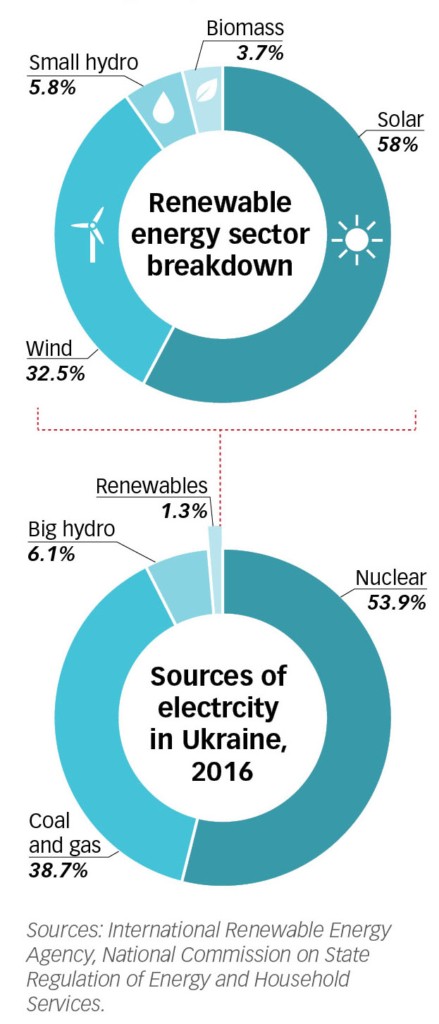Millions of Ukrainians could slash their energy bills by as much as 40 percent, on average, with the right efficiency-boosting measures. But a lack of expertise and investment capital are slowing progress, according to civil society groups and non-governmental organizations.
The United Nations Development Program and the American government’s development agency, the U. S. Agency for International Development, are working to address the shortcomings.
Their programs tie into goals that Ukraine has set for itself at the national level, with Prime Minister Volodymyr Groysman saying on July 12 that Ukraine should seek to become energy independent by 2020.
Boosting energy generated from renewable sources and making better use of already existing resources are both key parts of that strategy.
But the challenges to advancing energy efficiency in Ukraine are more than just practical. There is also a cultural element, with awareness and understanding of the issue growing but still “in its infancy,” according to Janthomas Hiemstra, country director at the United Nations Development Program.
“Ukraine is missing the boat in some ways,” Hiemstra told the Kyiv Post. “The culture and the thinking here is just from a different planet and some of the more advanced thinking is probably where you see the capacity deficiency. It’s all very new for this country.”
Experts working in the sector estimate that just a small fraction of Ukraine’s residential and municipal buildings have so far been made energy efficient.
Hundreds of millions of dollars have already been raised for projects, but some $90 billion more — 90 percent of Ukraine’s annual gross domestic product — is needed to complete work on a national scale, according to Sergiy Savchuk, the head of Ukraine’s State Agency on Energy Efficiency.
So far, success has often come in the form of individual residents or associations of homeowners securing financing to invest in energy-saving measures.
Figures provided by the USAID-backed Municipal Energy Reform Project show that, with the State Agency for Energy Efficiency, it had by the end of last month helped secure 219,294 loans for energy efficiency measures in the residential sector worth $147 million. That figure has grown from a little under 4,000 loans issued as of June 2015.
The head of the USAID project, Diana Korsakaite, says the huge jump in demand for loans over the past two years has been stimulated by several factors, including informational campaigns and rises in the prices of household energy bills. One of the biggest influences has been homeowners seeing the success of others.
“The example of your neighbor who lives in a nice, renovated house is very powerful,” she told the Kyiv Post.
Hiemstra, meanwhile, said the United Nations Development Program, which has worked with residents’ associations in 460 locations across Ukraine, had witnessed a “huge mushroom effect,” with groups of homeowners eager to implement energy efficiency measures once they see how much money it is possible to save.
“The business case is very solid,” Hiemstra said. “The benefits to individuals, particularly during winter months is really huge.”
But barriers remain to wide adoption of energy efficiency in homes, with many apartment owners reluctant to invest their own money. Instead, they still have the mentality that such work should be undertaken by the government.

Nuclear power is the biggest source of electricity in Ukraine, according to 2016 figures. Renewable sources, excluding big hydroelectric stations, accounted for just 1.3 percent of the total.
“If people are not ready, if the majority of a building’s residents do not recognize the fact that it is their private building which they all jointly own, any sort of energy efficiency project is going to be impossible,” according to Nadia Sergiyenko, a project manager at the Kyiv-based non-governmental organization Municipal Energy.
Public-private partners
Apart from residential, the public sector is another area where huge energy savings are possible. A big push is now under way to promote Energy Service Contracting, a scheme which seeks to attract the private sector to invest in energy efficiency measures in public buildings.
According to Savchuk of the State Agency for Energy Efficiency, there are currently only 20 such contracts active in Ukraine, but 100 more are expected to be concluded this year.
The United Nations Development Program, meanwhile, has 10 of its own pilot projects in the pipeline. They will be concentrated on municipal buildings in smaller cities where knowledge of energy saving is minimal and budgets for such work small or non-existent.
Hiemstra says even with interest rates on loans in Ukraine currently at 20 percent, energy efficiency investments in the municipal sector can be highly profitable but often require novel financing solutions to be found.
He told the Kyiv Post that the model to be piloted in Ukraine has brought lasting benefits to other countries.
“If it catches on and people start liking it, then of course they’ll do it without the assistance of an international organization,” he said. “The commercial banks have their interest, the service providers will find more markets and the municipalities and others will say, ‘who will do this for me?’”
